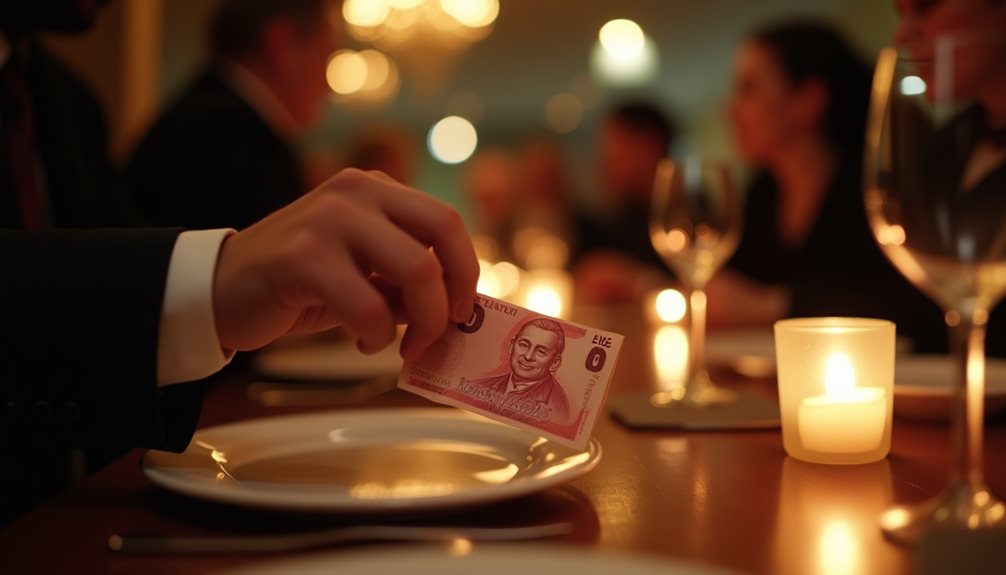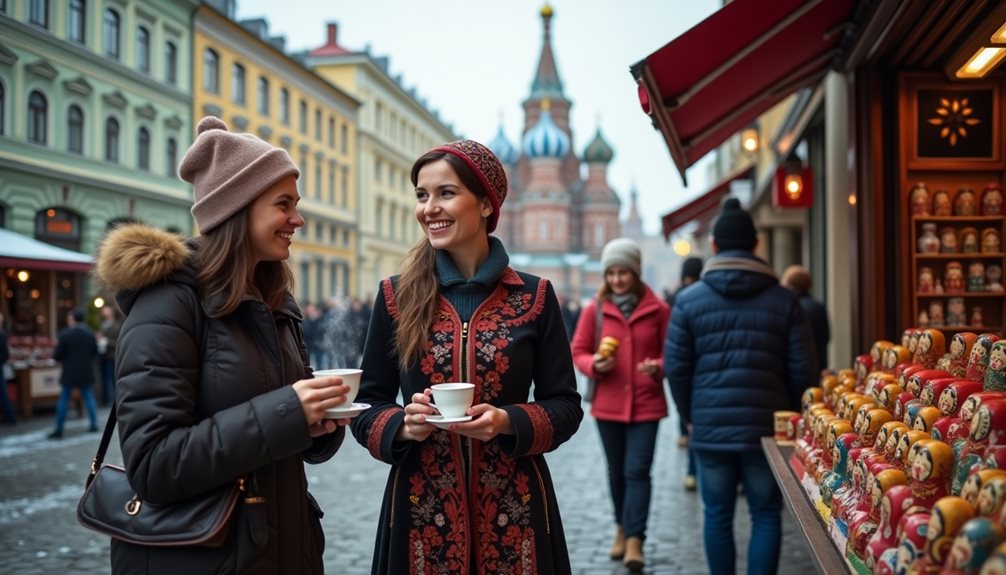Table of Contents
ToggleUnderstanding Greetings and Introductions

In Russia, greetings and introductions often reflect the country’s rich cultural heritage and social norms. The initial encounter is steeped in cultural nuances, where a firm handshake is customary, accompanied by direct eye contact to convey sincerity and respect.
Body language plays a pivotal role; a relaxed posture can indicate openness, while crossed arms may suggest defensiveness. Titles and surnames are typically used until a more familiar relationship is established, illustrating a preference for formality.
Additionally, the Russian custom of bringing a small gift when visiting someone’s home underscores the importance of hospitality. As travelers navigate these practices, awareness of these subtleties can foster genuine connections and demonstrate respect for the host culture, enriching their experience in Russia.
| English | Russian (Cyrillic + Phonetic) | Meaning |
|---|---|---|
| Firm handshake | Крепкое пожатие руки (Kryepkoye pozhatie ruki) | A strong and confident handshake as a greeting. |
| Direct eye contact | Прямой зрительный контакт (Pryamoy zritel’nyy kontakt) | Looking directly into someone’s eyes to show sincerity. |
| Convey sincerity and respect | Выражать искренность и уважение (Vyrazhat’ iskrennost’ i uvazheniye) | Showing honesty and respect through behavior. |
| Relaxed posture | Расслабленная поза (Rasslablennaya poza) | Body language that shows openness and comfort. |
| Crossed arms | Скрещенные руки (Skreshchennyye ruki) | Body language often interpreted as defensiveness. |
| Use of titles and surnames | Использование титулов и фамилий (Ispol’zovaniye titulov i familiy) | Formal way of addressing people by their title and last name. |
| More familiar relationship | Более близкие отношения (Boleye blizkiye otnosheniya) | A closer, less formal relationship between people. |
| Bringing a small gift | Приносить небольшой подарок (Prinosit’ nebol’shoy podarok) | Custom of giving a small present when visiting someone’s home. |
| Importance of hospitality | Важность гостеприимства (Vazhnost’ gostepriimstva) | The cultural value placed on being a good host. |
| Foster genuine connections | Способствовать искренним связям (Sposobstvovat’ iskrennim svyazyam) | Building real and honest relationships with others. |
![]()
Dining Etiquette: What You Need to Know
Dining in Russia presents a unique blend of tradition and etiquette that travelers should understand to navigate social gatherings smoothly. Observing proper table manners is essential; guests are typically expected to wait for the host to signal when to begin eating.
Dining rituals often include toasting with vodka, a significant cultural element that emphasizes camaraderie. It is polite to maintain eye contact when toasting and to never leave a glass empty.
Additionally, diners should refrain from placing elbows on the table and should use utensils properly, as these practices reflect respect for the meal and the company.
Understanding these nuances transforms a simple dining experience into a rich cultural exchange, allowing for deeper connections and appreciation of Russian hospitality.
When dining in Russia, it’s important to understand the customs and etiquette to make a good impression and enjoy the experience fully. Russian dining etiquette combines respect for tradition with social manners that might be different from what English speakers are used to. Here are key points and some helpful Russian words related to dining.
Key Points of Russian Dining Etiquette
- Wait for the Host’s Signal
In Russia, guests usually wait until the host says “Приятного аппетита!” (Priyatnogo appetita!) which means “Enjoy your meal!” before starting to eat. Starting before the host can be seen as rude.
- Toasting is Important
Toasting (to say cheers) with vodka or other drinks is a strong tradition. When someone makes a toast, you should:- Maintain eye contact with the person giving the toast.
- Never leave your glass empty during a toast.
- Drink after the toast is finished.
- No Elbows on the Table
Keeping your elbows off the table shows good manners and respect. Rest your hands on your lap or the edge of the table instead.
- Use Utensils Properly
Russians typically use a fork in the left hand and a knife in the right hand while eating. It’s considered polite to handle utensils carefully and not to play with them.
- Do Not Rush
Meals in Russia can be long, social events. Take your time, enjoy the food and conversation.
Common Russian Dining Terms
| Cyrillic | English Phonetic | English Definition |
|---|---|---|
| Стол (stol) | stohl | Table |
| Вилка (vilka) | VIL-kah | Fork |
| Нож (nozh) | nozh | Knife |
| Ложка (lozhka) | LOHZH-kah | Spoon |
| Бокал (bokal) | boh-KAHL | Wine glass/any drinking glass |
| Тост (tost) | tost | Toast (cheers) |
| Водка (vodka) | VOHD-kah | Vodka |
| Хлеб (khleb) | khlyeb | Bread |
| Приятного аппетита! (priyatnogo appetita!) | pree-YAT-nuh-vuh ah-pye-TEE-tah | Enjoy your meal! (said before eating starts) |
| За здоровье! (za zdorovye!) | zah zda-ROH-vee-yeh | To health! (a common toast) |
![]()
Example of a Toast in Russian:
- Host says: “За здоровье!” (Za zdorovye!) – “To health!”
- Everyone clinks glasses, looks each other in the eye, and drinks.
Summary
Understanding these details will help you feel more comfortable and respected when dining in Russia. Proper etiquette is always appreciated and shows respect for Russian culture and hospitality.
Dress Code: Dressing Appropriately for Different Occasions -(Одежда: Правильный выбор одежды для разных случаев)
Travelers to Russia quickly discover that dressing appropriately is an essential aspect of social interaction, reflecting respect for local customs and traditions.
In professional settings, business attire is paramount; tailored suits for men and elegant dresses or suits for women convey professionalism and seriousness. Conversely, casual wear is acceptable in relaxed environments, though it remains advisable to avoid overly revealing or sloppy clothing.
Russians often appreciate a polished appearance, even during informal gatherings. Seasonal variations also play a significant role; winter necessitates warm, stylish outerwear, while summer calls for breathable fabrics.
When learning Russian and preparing to visit or live in Russia, understanding how to dress appropriately is very important. Dressing correctly is a sign of respect for the people you meet and the situations you are in. Russians often pay close attention to clothing, and this applies to many social and professional settings.
Professional Settings (Деловая обстановка)
In Russia, business attire is usually formal and conservative:
- Men wear tailored suits (костюм, kostyum) with a shirt (рубашка, rubashka) and tie (галстук, galstuk).
- Women wear elegant dresses (платье, plat’ye) or suits (костюм, kostyum), often paired with modest accessories.
- Clean, polished shoes (туфли, tufli) are essential for both men and women.
This style shows professionalism and seriousness. Casual work clothes are generally not accepted in offices or meetings unless the company culture is explicitly more relaxed.
Casual Settings (Повседневная обстановка)
Outside of work, Russians still prefer neat and tidy clothing:
- Avoid overly revealing or sloppy clothing.
- Casual wear like jeans (джинсы, dzhinsy), shirts (рубашки, rubashki), sweaters (свитер, sviter), and casual shoes (кроссовки, krossovki) are common.
- Even informal gatherings often call for a polished look.
Seasonal Considerations (Сезонные особенности)
Russia has distinct seasons, and dressing according to the weather is crucial:
- Winter (зима, zima): Temperatures can be very cold. Warm coats (пальто, pal’to), scarves (шарф, sharf), hats (шапка, shapka), gloves (перчатки, perchatki), and boots (ботинки, botinki) are necessary.
- Summer (лето, leto): Light clothing made of breathable fabrics like cotton (хлопок, khlopok) or linen (лен, len) is preferred due to warm temperatures.
- Spring and autumn often require layered clothing because the weather changes quickly.
Russian Terms on Dress Code
| Cyrillic | English Phonetic | English Definition |
|---|---|---|
| одежда | odezhda | clothing |
| костюм | kostyum | suit |
| платье | plat’ye | dress |
| рубашка | rubashka | shirt |
| галстук | galstuk | tie |
| туфли | tufli | dress shoes |
| джинсы | dzhinsy | jeans |
| свитер | sviter | sweater |
| кроссовки | krossovki | sneakers/casual shoes |
| пальто | pal’to | coat |
| шарф | sharf | scarf |
| шапка | shapka | hat |
| перчатки | perchatki | gloves |
| ботинки | botinki | boots |
| хлопок | khlopok | cotton |
| лен | len | linen |
![]() Understanding these words helps you talk about clothing in Russian and prepare for various occasions while showing respect to Russian culture.
Understanding these words helps you talk about clothing in Russian and prepare for various occasions while showing respect to Russian culture.
Gift Giving Customs: How to Make a Good Impression
Social interactions in Russia often extend beyond mere conversation, with gift giving serving as a significant gesture of goodwill and respect.
When presenting gifts, travelers should be mindful of the symbolic nature behind their choices. Popular options include traditional items, such as matryoshka dolls or local delicacies, which reflect cultural appreciation.
Equally important is the art of gift wrapping; meticulous presentation demonstrates thoughtfulness and care. Brightly colored paper or fabric, often tied with a ribbon, enhances the overall impact.
It is advisable to avoid giving gifts in sets of four, as this number is associated with death.
Ultimately, a well-chosen, thoughtfully wrapped gift can forge lasting connections and leave a positive impression on Russian hosts.
Gift giving is an important part of social interactions in Russia. It is more than just a polite gesture; it shows respect, goodwill, and appreciation. If you are visiting Russia or meeting Russian people, understanding their gift giving customs will help you create a positive impression and build strong relationships.
What to Give?
When choosing a gift in Russia, think about items that show cultural respect or personal thoughtfulness. Here are some popular choices:
- Matryoshka dolls (матрёшка, matryoshka) – Traditional Russian nesting dolls that symbolize family and continuity.
- Local delicacies like honey (мёд, myod), caviar (икра, ikra), or chocolates (шоколад, shokolad) – These are appreciated as gifts because they represent Russian culture and taste.
- Souvenirs with Russian themes – For example, items featuring famous Russian landmarks or folk art.
- Flowers – If you give flowers, make sure the number is odd because even numbers are associated with funerals.
How to Present the Gift?
In Russia, how you wrap a gift matters almost as much as what you give. The presentation shows your care and respect for the recipient.
- Use brightly colored paper or fabric for wrapping.
- Tie the gift with a ribbon (лента, lenta) for a neat look.
- Avoid wrapping gifts in sets of four because the number four is linked to death in Russian culture.
- Sometimes gifts are given in person with both hands as a sign of respect.
Things to Avoid
- Do not give sharp objects like knives or scissors because they can symbolize cutting a relationship.
- Avoid gifts in sets of four (четыре, chetyre).
- Be careful with the color of wrapping paper; black or dark colors are linked to mourning.
Russian Terms Related to Gift Giving
| Cyrillic | Phonetic | English Definition |
|---|---|---|
| подарок | podarok | gift |
| дарить | darit’ | to give (a gift) |
| подарок на память | podarok na pamyat’ | souvenir |
| лента | lenta | ribbon |
| упаковка | upakovka | packaging, wrapping |
| цветы | tsvety | flowers |
| матрёшка | matryoshka | Russian nesting doll |
| шоколад | shokolad | chocolate |
| мёд | myod | honey |
| икра | ikra | caviar |
| уважение | uvazheniye | respect |
| традиция | traditsiya | tradition |
![]() Using these words can help you talk about gifts and understand conversations related to gift giving in Russian.
Using these words can help you talk about gifts and understand conversations related to gift giving in Russian.
By following these customs and understanding the cultural meaning behind gifts and presentation, you will make a good impression and show true respect in Russian social settings.
Personal Space and Physical Contact in Social Interactions
While traversing personal space and physical contact in Russia, it becomes evident that cultural norms greatly influence interactions. Russians often maintain closer proximity during conversations compared to many Western cultures, suggesting a comfort with reduced personal boundaries.
However, this closeness can vary markedly depending on the context and the relationship between individuals. For instance, friends and family may engage in frequent embraces and gestures, while acquaintances typically maintain a more reserved demeanor.
Understanding these cultural nuances is essential for travelers; misreading such signals may lead to discomfort. Additionally, physical contact, like a firm handshake, is customary in formal settings, symbolizing respect.
Observing these dynamics can enhance social interactions and foster deeper connections within the rich fabric of Russian culture.
When learning about Russian culture, especially for English speakers, understanding personal space and physical contact is very important. Russians generally stand closer to each other during conversations than people in many Western countries, like the United States or the UK. This means that personal boundaries are smaller, and people are more comfortable being physically near each other.
Closeness and Context
The amount of closeness depends a lot on who you are talking to. For example:
- Friends and family: They often hug, pat on the back, or even hold hands in some cases. This shows warmth and affection.
- Acquaintances or strangers: They usually keep a bit more distance and avoid too much physical contact, except perhaps a handshake.
In Russia, it is common to greet someone with a firm handshake in formal or business settings. A weak handshake might be seen as a lack of confidence or respect.
Why This Matters for Travelers
If you don’t understand these cultural differences, you might feel uncomfortable or accidentally offend someone. For example, if you step back because someone is standing close, they might think you are being cold or unfriendly. Or if you don’t return a firm handshake, it could come across as rude.
Russian Terms for Personal Space and Physical Contact
| Russian (Cyrillic) | Phonetic (English) | English Definition |
|---|---|---|
| личное пространство | lichnoye prostranstvo | personal space |
| прикосновение | prikosnovenie | touch / physical contact |
| рукопожатие | rukopozhatiye | handshake |
| обнимать | obnimat’ | to hug |
| друг | drug | friend |
| семья | sem’ya | family |
| уважение | uvazheniye | respect |
| близость | blizost’ | closeness (physical or emotional) |
| дистанция | distantsiya | distance |
| знакомый | znakomy | acquaintance |
![]()
These words can help you understand conversations about social behavior in Russian and prepare you for real-life interactions.
This explanation should support your understanding of how Russians approach personal space and physical contact differently from many English-speaking cultures.
Tipping Practices: When and How Much to Tip

Steering through the nuances of social interactions in Russia extends to understanding the country’s tipping practices, which reflect both cultural values and expectations in various service contexts.
In restaurants, a service charge is often included in the bill, yet leaving an additional 10-15% is customary if the service exceeds local expectations.
Bars and cafes similarly benefit from small tips, while taxi drivers appreciate rounding up the fare.
In hotels, tipping porters and housekeeping staff is also welcomed, though it remains less formalized.
Understanding these practices not only enhances the travel experience but also signifies respect for local customs.
Adhering to these tipping norms can foster goodwill, creating a more enriching interaction with the Russian culture.
When visiting Russia, understanding tipping customs is important because it shows respect for local culture and can improve your experience. Tipping in Russia has some differences compared to other countries, so let’s break down when and how much to tip in various situations.
Restaurants
- Service charge: In many restaurants, a service charge is already included in the bill (usually around 10%).
- Extra tip: If the service is especially good, it’s common to leave an additional 10-15% of the total bill as a tip.
- How to tip: You can either leave the tip in cash or tell the waiter to add it to the credit card payment.
Example: If your bill is 1000 rubles, and you want to leave a 15% tip, that would be 150 rubles extra.
Bars and Cafes
- Small tips are appreciated but not always expected.
- Rounding up to the nearest 10 or 20 rubles is common.
Example: If your coffee costs 90 rubles, you might give 100 rubles and say “keep the change.”
Taxi Drivers
- Taxi drivers often expect a small tip.
- Rounding up the fare to the nearest 50 or 100 rubles is usual.
Example: If your fare is 370 rubles, giving 400 rubles is a polite gesture.
Hotels
- Tipping porters (носильщик — nosil’shchik) who carry your luggage: about 50-100 rubles per bag.
- Housekeeping staff can be tipped around 50-100 rubles per day.
- Tipping hotel staff is less formal but appreciated for good service.
Table of Russian Tipping Terms
| Russian (Cyrillic) | English Phonetic | English Definition |
|---|---|---|
| Чаевые | Chaevyye | Tips |
| Официант | Ofitsiant | Waiter/Waitress |
| Таксист | Taksist | Taxi driver |
| Носильщик | Nosil’shchik | Porter |
| Уборщица | Uborshchitsa | Housekeeper |
| Кафе | Kafe | Cafe |
| Ресторан | Restoran | Restaurant |
| Счёт | Schyot | Bill/check |
| Обслуживание | Obsluzhivanie | Service |
![]()
Knowing these tipping customs and related words can help you navigate social situations smoothly during your stay in Russia. It shows respect and appreciation for good service, which is always welcomed.
Respecting Local Traditions and Customs During Festivals
How do travelers navigate the vibrant fabric of Russian festivals while respecting local traditions and customs? Understanding the significance of festival attire is essential. Wearing traditional garments or at least dressing modestly signals respect for the rich heritage on display.
During traditional celebrations, such as Maslenitsa or Ivan Kupala, participants often engage in age-old customs, from folk dances to communal feasting. Travelers should observe and participate mindfully, ensuring they honor the cultural context rather than overshadow it.
Engaging with local artisans and enjoying authentic cuisine further enriches the experience, fostering a genuine connection. Ultimately, embracing the essence of these festivals while being considerate of established customs allows travelers to immerse themselves fully in Russia’s vibrant cultural landscape.
When traveling to Russia, especially during traditional festivals, it is important to respect the local customs to fully appreciate the culture and avoid misunderstandings. Russian festivals are rich with history, music, dance, food, and clothing that are deeply meaningful to the people. Here’s how travelers can navigate these vibrant celebrations respectfully.
Understanding Festival Attire
In Russia, traditional clothing is often worn during festivals to honor the past and express cultural pride. Wearing traditional garments like the sarafan (a type of long dress) or at least dressing modestly shows respect for these customs. Avoiding overly casual or revealing clothes is a good rule of thumb.
- Sarafan (Сарафан, sah-rah-FAHN): A traditional Russian sleeveless dress worn by women.
- Kosovorotka (Косоворотка, koh-sah-vah-ROHT-kah): A traditional Russian shirt for men with a slanting collar.
Dressing appropriately signals that you value the cultural significance of the festival and are not just a tourist looking for entertainment.
Participating Mindfully in Traditions
Many Russian festivals involve age-old customs like singing folk songs, dancing in circles, or lighting bonfires. For example:
- Maslenitsa (Масленица, mahs-LYEH-nee-tsah): A week-long festival before Lent celebrating the end of winter with pancakes (blini), songs, and games.
- Ivan Kupala (Иван Купала, ee-VAHN koo-PAH-lah): A midsummer celebration with rituals involving fire and water, such as jumping over bonfires and searching for magical fern flowers.
Travelers should observe first and join in only when invited or when it feels appropriate. Being respectful means not interrupting rituals or taking photos without permission.
Engaging with Local Artisans and Cuisine
Festivals often feature craftspeople selling handmade goods like painted wooden toys or embroidered cloth. Trying local foods like blini (thin pancakes) or pirozhki (small stuffed buns) adds to the experience.
- Blini (Блины, blee-NEE): Thin Russian pancakes, often served with sour cream, caviar, or jam.
- Pirozhki (Пирожки, pee-rohsh-KEE): Small baked or fried buns filled with meat, cabbage, or potatoes.
Talking with artisans about their crafts or asking about dishes shows appreciation and helps create genuine connections.
Russian Terms Related to Festivals
| Cyrillic | Phonetic | English Definition |
|---|---|---|
| Праздник | prazd-neek | Festival, holiday |
| Традиция | tra-DEE-tsiya | Tradition |
| Обычай | ob-YCH-ai | Custom |
| Народный танец | na-ROD-ny ta-NYETS | Folk dance |
| Костюм | kos-TYOOM | Costume, outfit |
| Народная музыка | na-ROD-naya moo-ZEE-ka | Folk music |
| Ремесло | re-MES-lo | Craft, artisan work |
| Масленица | mahs-LYEH-nee-tsa | Maslenitsa festival |
| Иван Купала | ee-VAHN koo-PAH-la | Ivan Kupala festival |
| Блины | blee-NEE | Pancakes |
| Пирожки | pee-rosh-KEE | Small stuffed buns |
![]() By learning these terms and understanding their cultural importance, travelers can feel more confident and respectful while enjoying Russian festivals. This approach leads to a richer and more rewarding experience.
By learning these terms and understanding their cultural importance, travelers can feel more confident and respectful while enjoying Russian festivals. This approach leads to a richer and more rewarding experience.
Test Yourself on Essential Cultural Etiquette in Russia
1. What is the customary way to greet someone in a formal setting in Russia?
a) A light wave and smile
b) A firm handshake with direct eye contact
c) A bow from the waist
Correct answer:
b) A firm handshake with direct eye contact
2. When dining in Russia, what should guests wait for before starting to eat?
a) When the food is served
b) When the host says “Приятного аппетита!” (Enjoy your meal!)
c) When everyone is seated
Correct answer:
b) When the host says “Приятного аппетита!” (Enjoy your meal!)
3. Which of the following is considered inappropriate as a gift in Russia?
a) Matryoshka dolls
b) Gifts wrapped in sets of four
c) Local delicacies like honey or chocolates
Correct answer:
b) Gifts wrapped in sets of four
Frequently Asked Questions
![]()
What Languages Are Commonly Spoken in Russia Besides Russian?
In Russia, cultural diversity manifests through various regional languages, including Tatar, Bashkir, and Chechen. These languages reflect the country’s rich ethnic fabric, showcasing the unique identities and traditions of its numerous indigenous communities.
![]()
Are There Any Specific Cultural Taboos to Avoid in Russia?
Understanding cultural taboos in Russia reveals the importance of greeting customs, such as avoiding direct handshakes across thresholds. Additionally, dining etiquette emphasizes never discussing politics at the table, ensuring a respectful atmosphere during meals.
![]()
How Do Russians Typically Celebrate Birthdays?
Russians celebrate birthdays with vibrant traditions, often gathering family and friends for lively feasts. Gift etiquette typically involves thoughtful presents, and it’s customary to express gratitude and share toasts, enhancing the communal spirit of the occasion.
![]()
What Is the Significance of Traditional Russian Folk Art?
Traditional Russian folk art holds significant cultural value, reflecting regional identity through vibrant traditional crafts. Infused with folk symbolism, these artworks convey stories and beliefs, serving as a bridge between the past and contemporary expressions of creativity.
![]()
How Should I Behave in Public Transportation in Russia?
In public transportation, individuals should exhibit calmness and respect. Observing proper public behavior includes yielding seats to elders, minimizing noise, and refraining from eating. Transportation etiquette reflects a community’s values, fostering harmony among diverse passengers.



